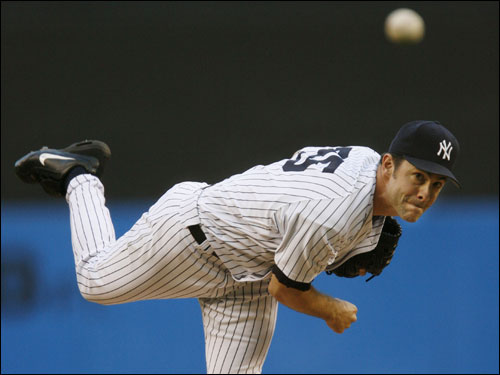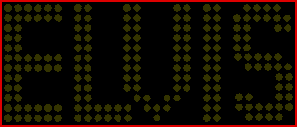I. Thou Shalt Not Try to Contrive Clever Puns on Joba's Name.
No "Joba the Hutt" or "Joba the Heat" or "Joba Fett" or "Gotta Getta Joba" or "Take this Joba and Shove It" or anything of the sort. Enough, already. He's got a nickname. It's "Joba". His real name is Justin. If he wants a better nickname, let him do something in the postseason to earn it.
II. In Case of John Sterling, Thou Shalt See Rule I.
"A great job-a, by Joba"???? "Joba gets the job-a done"???? This is the best you can do?!
III. Thou Shalt Not Mispronounce Joba's Name.
It's JAH-ba. Not JOE-ba.
IV. Thou Shalt Not Continually Refer to the Original "Joba Rules" or "Book of Joba".
These appear to have fallen out of use.
Chamberlain's original handling rules included that he should not be brought in to pitch in the middle of an inning, but he did this on September 19th, relieving Andy Pettitte by striking out Melvin Mora with two outs in the 8th.
In addition, he is supposed to get two days of rest if he pitches two innings, but this rule has apparently been scrapped as well. Having pitched two full innings (30 pitches) on September 21st, he then came in to pitch after only one day of rest, on September 23rd (again with two outs in the 8th, tisk-tisk) and picked up his first Major League Save. This was the day after the Yankees had used 10 different pitchers in a 12-11, extra inning win over Toronto, so they were admittedly a little short handed (armed?) the next afternoon, but let's not pretend like Joe Torre and the Yankees have some priority higher than winning, shall we?
The last of these Rules, that Joba should not be used on consecutive days, is likely to be scrapped some time in the playoffs, wherein many of the games are played on consecutive days, and all are crucial. This is especially likely if Joba threw only a handful of pitches the night before and/or Torre needs him to get Manny Ramirez or Vlad Guererro or David Wright out in a pinch.
Mark my words. The original Joba Rules never outweigh the Steinbrenner Rules, which number exactly one:
1) WIN, OR YOU'RE FIRED.
V. Thou Shalt Not Attribute Joba's Fastball to his Size.
Joba is 6'2" and 230 lbs and can throw a baseball over 100 mph. Billy Wagner is listed at 5'10" and 180 lbs and in his prime, he could throw over 100 mph. I am 6'5", 255 lbs and my fastball would not get pulled over for speeding in a School Zone at 3PM, much less an Interstate. Clearly size has very little to do with it.
VI. Thou Shalt Not Refer to Joba's Native American Heritage as Though it Presented a Significant Roadblock to MLB.
Not to diminish the history of hardships suffered by the Native American people, which have been both real and severe, nor the currently sad state of affairs on many Indian reservations. I should know, as I used to be Native American myself (it's a long story). But the kid throws 100 miles per hour! If you can throw 100 mph with some semblance of accuracy, it doesn't matter if you're descended from Indians or Martians or antelope. It won't matter if your skin is black or red or green or purple or teal with orange stripes and a sort of light yellow hint of plaid. You will get a college scholarship, and if you help the Nebraska Cornballers get into the College World Series, a major league scout will find you.
VII. Thou Shalt Not Pretend That Joba's Being Native American is New to MLB.
Baseball Almanac lists nearly 50 players whom they identify as having some significant portion of Indian ancestry, including Hall of Famers Charles "Chief" Bender and Zach Wheat, All-Stars like Rudy York, "Indian" Bob Johnson, Allie "Superchief" Reynolds and Pepper Martin. In addition, according to baseball-almanac.com, Gene Bearden, Virgil Trucks, Hall of Famers Johnny Bench, Willie Stargell & Early Wynn, among others, have some share of Native American blood. As recently as 2005 there was a Native American in MLB, Bobby Madritsch, with the Mariners. Red Sox rookie Jacoby Ellsbury was in the majors as early as June 30th and has been playing regularly (hitting .367!) this September. (Incidentally, Ellsbury, not Joba, is the highest-drafted Native American in history. Many outlets, including the Allen Barra article in WSJ linked above, have erroneously stated the otherwise.)
VIII. Thou Shalt Not Continually Bring Up Joba's Father and His Polio, and His Poverty, and His Divorce, and His Appendix...
Harlan Chamberlain used to catch Joba when he was a kid, sitting in his wheelchair (the dad, not Joba) and he finally got to see him pitch in the majors, in person, on September 7th in Kansas City. He struck out a batter and allowed only one hit in two scoreless innings (Joba, not the dad), so he did not disappoint, and his dad must be extremely proud and very excited and gratified for all the hard work they did finally paying off.
But you're killing me, here. Can't we come up with something more cheerful to talk/write about? Can't we just be excited for the kid and the cool things he might do in the postseason? Do we have to be constantly reminded of his dad's condition? And that he had an emergency appendectomy and nearly died last summer? And that his wife left when Joba was 3? What's next? Tornados and smallpox and packs of wild, rabid dogs? It's baseball, folks. It's a game. Leave the family melodrama for another original HBO series or something.
IX. Thou Shalt Not Fawn All Over Joba Like He's The Greatest Pitching Prospect Ever.
Listen, I'm as excited about all the talent oozing out of the Yankee farm system this year as aynbody, but just because he started his career with 16 consecutive scoreless innings (in 12 games), don't think he's going to be unhittable for his whole career. Sure, he's got great stuff, but he did just turn 22, and nobody ever comes up to the majors and cruises through an entire career without a few bumps in the road.
The immortal Victor Cruz started his career in 1978 with Toronto, at age 20, and rattled off 21.1 consecutive scoreless innings. By age 26, he was out of baseball. Erstwhile Yankees prospect Matt Smith came up last year and pitched a dozen scoreless games with New York before being traded to Philadelphia, where he added ten more games to the streak, totaling 18.2 scoreless innings before allowing his first run in the majors. This April, Smith walked 11 and struck out only one batter, allowing 5 runs in 4 innings, before being sent back to the minors, where he pitched until June and then went on the DL.
In total, going back 50 years, 17 different pitchers have started their career with at least a dozen games in which they did not give up a run, and most of them did not even pitch 5 or 6 years in the major leagues. The best of these was Dick Radatz, the briefly great Red Sox reliever from the early 1960's, whose last really good year was his third in the majors. The longest-tenured of these was Bob McClure, a crafty lefty who managed to stick around for 19 seasons but racked up 10 Wins or 10 saves only once each.
Joachin Andujar wisely summarized this peculiarity in one word: Youneverknow.
X. Thou Shalt Not Make Joba a Reliever Next Year.
This one is particularly important, even though it only applies to the Yankees front office and not to, say, anyone who might actually read this. Chamberlain is (if you'll forgive the pun) setting himself up here to be the Closer of the Future. We all know that Mr. Automatic is hardly that anymore, and that the Yankees need to start grooming his replacement. Mo will be 38 next year and can't last forever. But please, please, don't let Joba follow in his footsteps. Granted, you could do a lot worse than to have Mariano Rivera's career. He's 3rd on the Career Saves list, and will likely be at least 2nd by the time he retires. With his frequent 1+ inning use and postseason success, he's as good a bet as any among the modern closers to get a plaque for himself in Cooperstown.
But Joba could be much more than that. As a rule, the Closer is an overrated commodity. The Cleveland Indians are cruising into the postseason with Joe Borowski, who leads the AL with 43 saves but has a 5.15 ERA. Clearly, Saves are not that hard to accomplish.
Last year, the Red Sox installed rookie Jonathan Papelbon as their closer, despite his impressive numbers as a starter in the minors, because they needed one so badly. He was so good at it (a 0.92 ERA, 75 strikeouts and 35 Saves in 68 innings) that he nearly won the Rookie of the Year Award, and now he can't get his job back as a starter, even though they promised it to him after last season.
With Roger Clemens likely to really, really (no seriously, he means it this time) retire after the season, and the uncertain nature of much of their starting rotation after Chien-Ming Wang (Pettitte's got a mutual option, Igawa's sketchy at best, Mussina's old, the rest are young and erratic) they'll need Chamberlain to give them 6 or 7 solid innings every 5 days if they're going to get to the Promised Land. They can't afford to give him 70 innings of work when they need 200 out of him. There isn't enough bonafide talent on the Yankees pitching staff to pick up all that slack.
So, in short, if you follow only one of these new Rules, let it be this one. Let the fans see Joba pitch as much as possible, within reason, and the team will be better for it.

 But this year? In 2007, he's down to 5.53 K's per nine, well below the MLB average of 6.59 whiffs per game. Unless you've got stellar defense behind you, pinpoint control and/or a cavernous ballpark, none of which is the case for Moose, you can't survive in the majors striking out a batter below the MLB average, at least not for long. (I know, I know:
But this year? In 2007, he's down to 5.53 K's per nine, well below the MLB average of 6.59 whiffs per game. Unless you've got stellar defense behind you, pinpoint control and/or a cavernous ballpark, none of which is the case for Moose, you can't survive in the majors striking out a batter below the MLB average, at least not for long. (I know, I know: 


 Phil Rizzuto's major league playing career started when he was 23 years old. A Brooklyn native, and only 5'6" tall, when he was called up from the minors in 1941, he supposedly had a hard time convincing the guard at
Phil Rizzuto's major league playing career started when he was 23 years old. A Brooklyn native, and only 5'6" tall, when he was called up from the minors in 1941, he supposedly had a hard time convincing the guard at 



